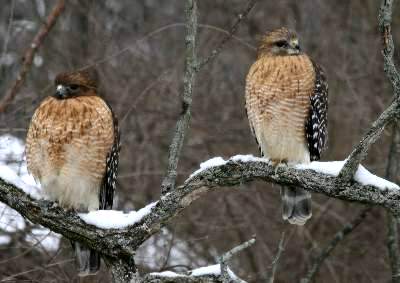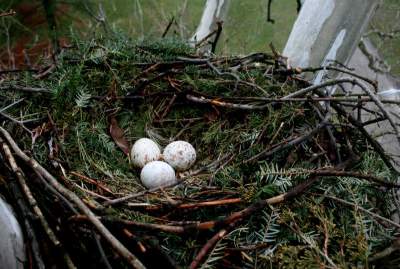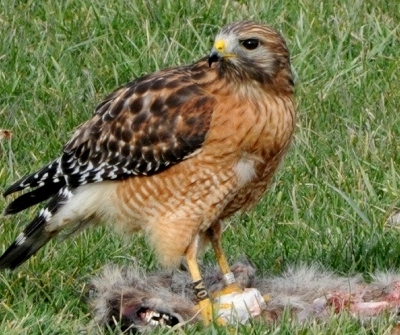Natural History
Red-Shouldered Hawks of Southwest Ohio
 Red-shouldered Hawks are members of the Buteo genus, the genus that
also contains Red-tailed Hawks, Broad-winged Hawks, and Rough-legged
Hawks. They live in a variety of habitats, including mature riparian
forest, flat wet woodlands, upland forests, and suburban areas with
sufficient numbers of mature trees. In the Cincinnati area, they are
permanent residents and live primarily in the suburban areas east and
west of the city, but occasionally in areas as developed as Amberley
Village, College Hill, Mt. Washington, and Delhi. Red-shouldered Hawks are members of the Buteo genus, the genus that
also contains Red-tailed Hawks, Broad-winged Hawks, and Rough-legged
Hawks. They live in a variety of habitats, including mature riparian
forest, flat wet woodlands, upland forests, and suburban areas with
sufficient numbers of mature trees. In the Cincinnati area, they are
permanent residents and live primarily in the suburban areas east and
west of the city, but occasionally in areas as developed as Amberley
Village, College Hill, Mt. Washington, and Delhi.
Nesting In our area, Red-shouldered Hawks begin courtship displays as
early as February. Behaviors include a series of repeated loud calls (kee,
kee, kee, kee, kee), and stooping flight displays. They start building a
new nest or refurbishing an old nest in mid-February. Nest tree species
include Sycamore, Ashes, Maples, Oaks, and other species, and nest trees
may be in wooded areas between houses, in parks, or in yards. Nests are
typically made in a large tree, in a crotch near the main trunk, 40-60’
above the ground. The nests are made exclusively of sticks, generally
averaging about 0.5” - 1” in diameter, and the hawks decorate the nest
with variety of branches of fresh green vegetation, broken off from
trees near the nest. The adults bring this “greenery” throughout the
breeding season, from the nest-building stage through fledging.
 Females
lay 2-4 speckled off-white eggs between mid-March and early April (March
23, on average). The female typically lays one egg every other day, but
begins incubation after laying the first. The female incubates the eggs,
exchanging occasionally with the male, for 32 days, and the semi-altricial
nestlings hatch in the order the eggs were laid, in late April (April
24, on average). Because of the asynchronous hatching, older nestlings
may be as much as 6-8 days more mature than the younger ones of the
brood. The nestlings remain in the nest for about 6 weeks. During the
first two weeks, the young are very dependent on the parents for warmth
and feeding. As they grow, they become more able to thermoregulate and
feed themselves, so that by the time the nestlings are ready to fledge,
the adults rarely stay in the nest for long. After fledging, the young
remain in the natal territory, and continue to depend on the adults for
feeding for at least one month. Females
lay 2-4 speckled off-white eggs between mid-March and early April (March
23, on average). The female typically lays one egg every other day, but
begins incubation after laying the first. The female incubates the eggs,
exchanging occasionally with the male, for 32 days, and the semi-altricial
nestlings hatch in the order the eggs were laid, in late April (April
24, on average). Because of the asynchronous hatching, older nestlings
may be as much as 6-8 days more mature than the younger ones of the
brood. The nestlings remain in the nest for about 6 weeks. During the
first two weeks, the young are very dependent on the parents for warmth
and feeding. As they grow, they become more able to thermoregulate and
feed themselves, so that by the time the nestlings are ready to fledge,
the adults rarely stay in the nest for long. After fledging, the young
remain in the natal territory, and continue to depend on the adults for
feeding for at least one month.
The young Red-shouldered Hawks look like a lot of other Buteo young,
with generally brown plumage on the back, head, and wings, and a creamy
white breast and belly heavily marked with dark brown spots. The young
do not develop the characteristic adult plumage, black-and-white
checkered wings, black-and-white striped tail, and rusty reddish
shoulders and breast, until they reach autumn of their second year. They
generally begin breeding during their first spring in adult plumage,
when they are nearly two years old.
 Diet. Red-shouldered Hawks are dietary generalists. They eat a variety
of prey items, including mainly small mammals (voles and mice,
occasionally chipmunks and squirrels), snakes, and amphibians (frogs),
and occasionally birds, insects, fish, terrestrial and aquatic
invertebrates, and carrion. Diet can vary between locations and between
years, depending on prey availability. Compared to Red-tailed Hawks,
Red-shoulders have relatively small feet, and cannot take prey items
larger than squirrels. Diet. Red-shouldered Hawks are dietary generalists. They eat a variety
of prey items, including mainly small mammals (voles and mice,
occasionally chipmunks and squirrels), snakes, and amphibians (frogs),
and occasionally birds, insects, fish, terrestrial and aquatic
invertebrates, and carrion. Diet can vary between locations and between
years, depending on prey availability. Compared to Red-tailed Hawks,
Red-shoulders have relatively small feet, and cannot take prey items
larger than squirrels.
This photo was taken by Barb
Mirlenbrink in Warren county at the
Symmes Public Library on Enyart Road,off Montgomery.
We banded this male as a nestling on 14 May 2002 at 2613 Ball Road, and
did not know where the bird had gone until Barb photographed him. At
nearly 10 years old, this bird is among the oldest known in our study
area.
|
 Red-shouldered Hawks are members of the Buteo genus, the genus that
also contains Red-tailed Hawks, Broad-winged Hawks, and Rough-legged
Hawks. They live in a variety of habitats, including mature riparian
forest, flat wet woodlands, upland forests, and suburban areas with
sufficient numbers of mature trees. In the Cincinnati area, they are
permanent residents and live primarily in the suburban areas east and
west of the city, but occasionally in areas as developed as Amberley
Village, College Hill, Mt. Washington, and Delhi.
Red-shouldered Hawks are members of the Buteo genus, the genus that
also contains Red-tailed Hawks, Broad-winged Hawks, and Rough-legged
Hawks. They live in a variety of habitats, including mature riparian
forest, flat wet woodlands, upland forests, and suburban areas with
sufficient numbers of mature trees. In the Cincinnati area, they are
permanent residents and live primarily in the suburban areas east and
west of the city, but occasionally in areas as developed as Amberley
Village, College Hill, Mt. Washington, and Delhi. Females
lay 2-4 speckled off-white eggs between mid-March and early April (March
23, on average). The female typically lays one egg every other day, but
begins incubation after laying the first. The female incubates the eggs,
exchanging occasionally with the male, for 32 days, and the semi-altricial
nestlings hatch in the order the eggs were laid, in late April (April
24, on average). Because of the asynchronous hatching, older nestlings
may be as much as 6-8 days more mature than the younger ones of the
brood. The nestlings remain in the nest for about 6 weeks. During the
first two weeks, the young are very dependent on the parents for warmth
and feeding. As they grow, they become more able to thermoregulate and
feed themselves, so that by the time the nestlings are ready to fledge,
the adults rarely stay in the nest for long. After fledging, the young
remain in the natal territory, and continue to depend on the adults for
feeding for at least one month.
Females
lay 2-4 speckled off-white eggs between mid-March and early April (March
23, on average). The female typically lays one egg every other day, but
begins incubation after laying the first. The female incubates the eggs,
exchanging occasionally with the male, for 32 days, and the semi-altricial
nestlings hatch in the order the eggs were laid, in late April (April
24, on average). Because of the asynchronous hatching, older nestlings
may be as much as 6-8 days more mature than the younger ones of the
brood. The nestlings remain in the nest for about 6 weeks. During the
first two weeks, the young are very dependent on the parents for warmth
and feeding. As they grow, they become more able to thermoregulate and
feed themselves, so that by the time the nestlings are ready to fledge,
the adults rarely stay in the nest for long. After fledging, the young
remain in the natal territory, and continue to depend on the adults for
feeding for at least one month.  Diet. Red-shouldered Hawks are dietary generalists. They eat a variety
of prey items, including mainly small mammals (voles and mice,
occasionally chipmunks and squirrels), snakes, and amphibians (frogs),
and occasionally birds, insects, fish, terrestrial and aquatic
invertebrates, and carrion. Diet can vary between locations and between
years, depending on prey availability. Compared to Red-tailed Hawks,
Red-shoulders have relatively small feet, and cannot take prey items
larger than squirrels.
Diet. Red-shouldered Hawks are dietary generalists. They eat a variety
of prey items, including mainly small mammals (voles and mice,
occasionally chipmunks and squirrels), snakes, and amphibians (frogs),
and occasionally birds, insects, fish, terrestrial and aquatic
invertebrates, and carrion. Diet can vary between locations and between
years, depending on prey availability. Compared to Red-tailed Hawks,
Red-shoulders have relatively small feet, and cannot take prey items
larger than squirrels.